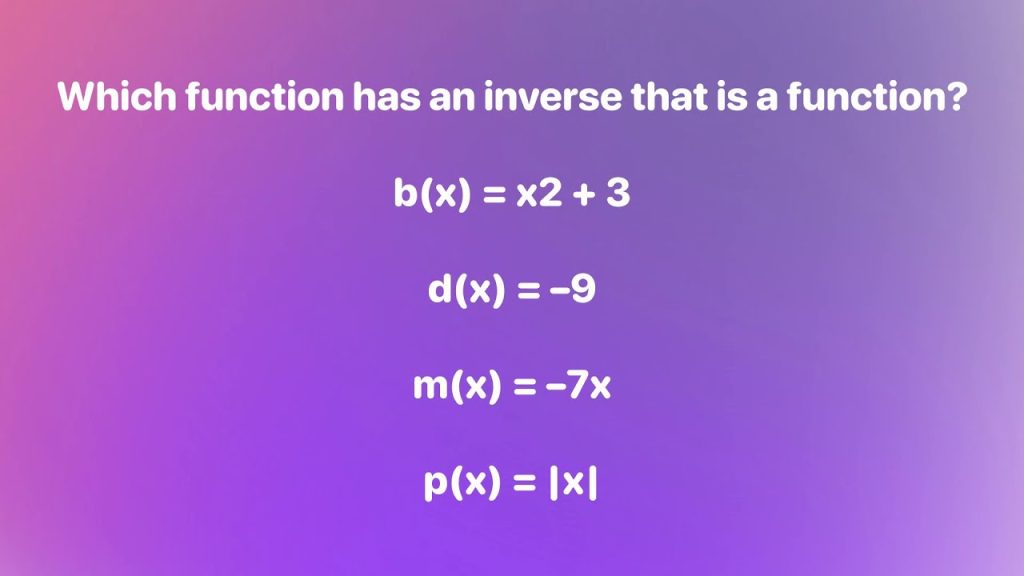
Intro
The ability to identify functions that possess both inverse functions is crucial for algebra and precalculus and reaches advanced mathematical subjects. Math-related standardized tests together with homework assignments and practical applications present these kinds of problems to students and educators and math enthusiasts. The paper examines the comprehensive inquiry about functions and their invertible properties. Which function has an inverse that is a function?
We will evaluate the following functions:
- b(x) = x² + 3
- d(x) = –9
- m(x) = –7x
- p(x) = |x|
Each function gets analyzed using the horizontal line test along with inverse function rules to reveal the concepts of one-to-one functions and their domain and range. Through reading this article you will develop the ability to determine which of these functions possess inverse functions that remain functions.
Understanding Inverses of Functions
Before diving into the specific functions, let’s first understand what an inverse function is.
What Is an Inverse Function?
An inverse function reverses the operation of a function. If a function f maps x to y, then its inverse f⁻¹ maps y back to x.
Mathematically, if:
f(x) = y
Then: f⁻¹(y) = x
For a function to have an inverse that is also a function, it must be one-to-one (1-1).
The Horizontal Line Test
The horizontal line test is used to determine if a function is one-to-one. Here’s how it works:
- If any horizontal line crosses the graph of a function more than once, then the function does not have an inverse that is a function.
- If every horizontal line crosses the graph only once, then the function does have an inverse that is also a function.
Analyzing Each Function
Let’s now analyze each of the given functions using the criteria above.
1. b(x) = x² + 3
This is a quadratic function. The standard form of a quadratic function is:
f(x) = ax² + bx + c
Here, b(x) = x² + 3 has a parabola shape opening upwards.
Is b(x) One-to-One?
No. For example:
- b(2) = 4 + 3 = 7
- b(–2) = 4 + 3 = 7
So, two different inputs produce the same output. This fails the horizontal line test.
Does b(x) Have an Inverse That Is a Function?
No, because it’s not one-to-one.
Graph Analysis:
The graph of x² + 3 is a symmetric parabola centered at the vertex (0, 3). Any horizontal line above the vertex intersects the parabola at two points, proving the function is not invertible as a function.
Conclusion: b(x) = x² + 3 does not have an inverse that is a function.
2. d(x) = –9
This is a constant function, which means it always returns –9, no matter what x is.
Is d(x) One-to-One?
No. For example:
- d(1) = –9
- d(2) = –9
- d(1000) = –9
It maps many inputs to the same output, so it is not one-to-one.
Horizontal Line Test:
The graph is a horizontal line. Every horizontal line (including itself) intersects it infinitely many times.
Does d(x) Have an Inverse That Is a Function?
No. There is no way to determine a unique input from the output –9.
Conclusion: d(x) = –9 does not have an inverse that is a function.
3. m(x) = –7x
This is a linear function of the form:
f(x) = mx + b, where m ≠ 0
Here, m = –7 and b = 0.
Is m(x) One-to-One?
Yes! Because it’s a straight line with a non-zero slope, it passes the horizontal line test.
Let’s test two different values:
- m(1) = –7
- m(–1) = 7
Different inputs always yield different outputs. So it’s one-to-one.
Does m(x) Have an Inverse That Is a Function?
Yes.
Let’s find the inverse:
y = –7x
Switch x and y:
x = –7y
Solve for y:
y = –x / 7
So, m⁻¹(x) = –x/7
Conclusion: m(x) = –7x does have an inverse that is a function.
4. p(x) = |x|
This is the absolute value function.
Its graph looks like a “V” shape, symmetrical around the y-axis. It opens upwards, with the vertex at (0, 0).
Is p(x) One-to-One?
No.
- p(3) = 3
- p(–3) = 3
Two different inputs map to the same output, which fails the horizontal line test.
Does p(x) Have an Inverse That Is a Function?
No.
Even though we could define a piecewise inverse (separately for x ≥ 0 and x < 0), the full function p(x) is not one-to-one, so its inverse is not a function.
Conclusion: p(x) = |x| does not have an inverse that is a function.
Final Answer
Of the four functions given:
- b(x) = x² + 3 → Not one-to-one
- d(x) = –9 → Not one-to-one
- m(x) = –7x → One-to-one (Inverse is a function)
- p(x) = |x| → Not one-to-one
Correct Answer: m(x) = –7x
Why Is This Important?
Knowing which functions have inverses that are also functions is not just a test question – it’s an essential concept in mathematics and applications like:
- Engineering: Signal processing and system modeling
- Computer Science: Cryptography and hashing
- Data Science: Reversible transformations
- Calculus: Understanding derivative rules of inverse functions
Quick Summary Table
| Function | One-to-One | Inverse Exists? | Inverse is a Function? |
| b(x) = x² + 3 | No | Partially | No |
| d(x) = –9 | No | No | No |
| m(x) = –7x | Yes | Yes | Yes |
| p(x) = | x | – | No |
Tips to Identify Inverses That Are Functions
- Apply the Horizontal Line Test: If a horizontal line hits more than once, it’s not invertible as a function.
- Check for One-to-One Behavior: A function must pair each output to exactly one input.
- Look at the Function Type:
- Linear functions (with non-zero slope)
- Quadratic and absolute value functions unless restricted to a domain
- Algebraically Solve for x: Switch x and y, and solve. If you can’t isolate y uniquely, it’s not a function.
Common Student Mistakes
- Assuming all functions have inverses that are functions: Not true! Only one-to-one functions do.
- Forgetting to switch x and y when solving for the inverse
- Not checking the full domain: Sometimes a function might seem invertible over part of its domain.
Conclusion
So, which function has an inverse that is a function?
The answer is:
m(x) = –7x
This function is linear, one-to-one, and passes the horizontal line test. Its inverse, m⁻¹(x) = –x/7, is also a valid function.
Successful mastery of advanced mathematics depends strongly on mastering inverse functions. Understanding how to identify invertibility helps you gain a valuable analytical tool that benefits studying exams and tutoring activities while personal exploration of mathematics.



